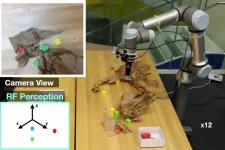Capturing the complex
Researchers create the first global assessment of cumulative human impacts to at-risk marine species over time
2021-04-01
(Press-News.org) (Santa Barbara, Calif.) -- Despite the fact that our planet is mostly ocean and human maritime activity is more intense than it has ever been, we know remarkably little about the state of the ocean's biodiversity -- the variety and balance of species that support healthy and productive ecosystems. And it's no surprise -- marine biodiversity is complex, human impacts are uneven, and species respond differently to different stressors.
"It is really hard to know how a species is doing by just looking out from your local coast, or dipping underwater on SCUBA," said Ben Halpern, a marine ecologist at the Bren School of Environmental Science & Management at UC Santa Barbara and Director of the National Center for Ecological Analysis and Synthesis. "You only see a small patch of where a species lives and what it is experiencing, and only the few species you happen to see on that day." Though valuable, these snapshots are only part of a much larger picture of cumulative human impacts on at-risk marine species. Even less obvious are changes in impact over time and assessments of vulnerability to these impacts, which differs across species.
However, the picture of marine biodiversity is about to get a lot clearer. In a first-of-its kind study published in the journal Science, Halpern, lead author Casey O'Hara and co-author Melanie Frazier broaden and deepen our understanding of the state of marine biodiversity with a global assessment of cumulative human impacts to at-risk marine species over a recent time period. Their findings could go a long way toward concrete conservation measures for the most vulnerable members of the marine community.
Multidimensional Mapping
"This is the first study of its kind looking at the effects of human activity on marine species, and the first looking at changes over time," said O'Hara, a doctoral student in the Bren School. Taking data on 1,271 threatened and near-threatened marine species from the International Union for Conservation of Nature and Natural Resources' (IUCN) Red List, the researchers mapped the at-risk species along range and anthropogenic stressors from 2003-2013.
"We focused on those species known to be at a higher risk of extinction because from a conservation perspective, it's especially important to understand where and how our activities continue to jeopardize those species," O'Hara said. "Not every species is affected the same way by various human activities -- some species are more sensitive to fishing pressures while others are more vulnerable to rising sea surface temperatures or ocean acidification." Mapping over a series of 11 years would also give the researchers a sense of cumulative human impact, a method they first employed in a previous study that focused on representative marine habitats.
It's not a shock. Human impacts on marine biodiversity are increasing, dominated by fishing, direct human disturbance from land and ocean acidification. But there were some unexpected discoveries for the authors. The extent to which at-risk species are facing these pressures from human activities, and the pace at which the pressures are expanding and intensifying, is worrisome. Corals are the most widely impacted marine organism on Earth.
"I was surprised at the extent to which corals were impacted -- coral species are facing impacts across essentially their entire ranges and those impacts are only getting more intense, particularly climate-related impacts," O'Hara said. "We hear stories of coral bleaching and the like, but our results really highlight the impact we are having." The species of the Coral Triangle -- the tropical waters connecting Indonesia, the Philippines, Papua New Guinea and the Solomon Islands -- are among the most affected by human impacts, as are species in the North Atlantic, North Sea and Baltic Sea.
The information from this approach could give decisionmakers a deeper understanding of where and how human activity is affecting marine biodiversity, which could lead to effective solutions. For instance, addressing areas of human impact overlap can maximize the benefits of conservation for several species in the area. Effective conservation measures can help ease the pressures of climate change phenomena such as ocean acidification or rising ocean temperatures.
The team might get the chance to put their findings to work later this year, at the U.N. Convention on Biological Diversity's 15th Conference of Parties, where 197 participating nations and territories will convene on a framework to protect and conserve global biodiversity.
"That framework will include targets for protecting land and ocean areas globally, along the lines of President Biden's executive order to protect 30% of U.S. lands and coastal waters by 2030," O'Hara said. "With our study we hope to highlight those areas where such protection can do the greatest good for those species and ecosystems at greatest risk."
INFORMATION:
ELSE PRESS RELEASES FROM THIS DATE:
2021-04-01
The humble lab mouse has provided invaluable clues to understanding diseases ranging from cancer to diabetes to COVID-19. But when it comes to psychiatric conditions, the lab mouse has been sidelined, its rodent mind considered too different from that of humans to provide much insight into mental illness.
A new study, however, shows there are important links between human and mouse minds in how they function -- and malfunction. Researchers at Washington University School of Medicine in St. Louis devised a rigorous approach to study how hallucinations are produced in the brain, providing a promising entry point to the development of much-needed new therapies for schizophrenia.
The study, published April 2 in ...
2021-04-01
Tropical rainforests today are biodiversity hotspots and play an important role in the world's climate systems. A new study published today in Science sheds light on the origins of modern rainforests and may help scientists understand how rainforests will respond to a rapidly changing climate in the future.
The study led by researchers at the Smithsonian Tropical Research Institute (STRI) shows that the asteroid impact that ended the reign of dinosaurs 66 million years ago also caused 45% of plants in what is now Colombia to go extinct, and it made way for the reign of flowering plants in modern tropical rainforests.
"We wondered how tropical rainforests changed after a drastic ecological perturbation such as the Chicxulub impact, so we looked for tropical plant fossils," said Mónica ...
2021-04-01
LA JOLLA--(April 1, 2021) Neurons lack the ability to replicate their DNA, so they're constantly working to repair damage to their genome. Now, a new study by Salk scientists finds that these repairs are not random, but instead focus on protecting certain genetic "hot spots" that appear to play a critical role in neural identity and function.
The findings, published in the April 2, 2021, issue of Science, give novel insights into the genetic structures involved in aging and neurodegeneration, and could point to the development of potential new therapies for diseases such Alzheimer's, Parkinson's and other age-related dementia disorders.
"This research shows for the first time that ...
2021-04-01
On the afternoon of April 13, 2018, a large wave of water surged across Lake Michigan and flooded the shores of the picturesque beach town of Ludington, Michigan, damaging homes and boat docks, and flooding intake pipes. Thanks to a local citizen's photos and other data, NOAA scientists reconstructed the event in models and determined this was the first ever documented meteotsunami in the Great Lakes caused by an atmospheric inertia-gravity wave.
An atmospheric inertia-gravity wave is a wave of air that can run from 6 to 60 miles long that is created when a mass of stable air is displaced by an air mass with significantly ...
2021-04-01
In recent years, robots have gained artificial vision, touch, and even smell. "Researchers have been giving robots human-like perception," says MIT Associate Professor Fadel Adib. In a new paper, Adib's team is pushing the technology a step further. "We're trying to give robots superhuman perception," he says.
The researchers have developed a robot that uses radio waves, which can pass through walls, to sense occluded objects. The robot, called RF-Grasp, combines this powerful sensing with more traditional computer vision to locate and grasp items that might otherwise be blocked from view. The advance could one day streamline e-commerce fulfillment in warehouses or help a machine pluck a screwdriver from a jumbled toolkit.
The research will be presented in May at the IEEE International ...
2021-04-01
Plant inducible defense starts with the recognition of microbes, which leads to the activation of a complex set of cellular responses. There are many ways to recognize a microbe, and recognition of microbial features by pattern recognition receptors (PRRs) outside the cell was long thought to activate the first line of defense: Pattern Triggered Immunity, or PTI. To avoid these defense responses, microbes of all kinds evolved the ability to deliver effector molecules to the plant cell, either directly into the cytoplasm or into the area just outside the cell, where they are taken up into the cytoplasm. ...
2021-04-01
New research published today in the journal Blood Advances is the first to show that restricting calories, reducing fat and sugar intake, and increasing physical activity may boost the effectiveness of chemotherapy for older children and adolescents with leukemia. This intervention, which improved chemotherapy outcomes for children being treated at two institutions, will be further studied through a national trial later this year.
B-cell acute lymphoblastic leukemia (B-ALL), a cancer affecting the white blood cells in the bone marrow, is the most common type of cancer in children. In the study, researchers assessed the effects of diet and exercise on 40 individuals aged 10-21 undergoing chemotherapy at ...
2021-04-01
In some cancers, including leukemia in children and adolescents, obesity can negatively affect survival outcomes. Obese young people with leukemia are 50% more likely to relapse after treatment than their lean counterparts.
Now, a study led by researchers at UCLA and Children's Hospital Los Angeles has shown that a combination of modest dietary changes and exercise can dramatically improve survival outcomes for those with acute lymphoblastic leukemia, the most common childhood cancer.
The researchers found that patients who reduced their calorie intake by 10% or more and adopted a moderate exercise program immediately after their diagnosis had, on average, 70% less ...
2021-04-01
For years, research to pin down the underlying cause of Alzheimer's Disease has been focused on plaque found to be building up in the brain in AD patients. But treatments targeted at breaking down that buildup have been ineffective in restoring cognitive function, suggesting that the buildup may be a side effect of AD and not the cause itself.
A new study led by a team of Brigham Young University researchers finds novel cellular-level support for an alternate theory that is growing in strength: Alzheimer's could actually be a result of metabolic dysfunction in the brain. In other words, there is growing evidence that diet and lifestyle are at the ...
2021-04-01
Los Angeles (April 1, 2021) -- Overweight children and adolescents receiving chemotherapy for treatment of leukemia are less successful battling the disease compared to their lean peers. Now, research conducted at the END ...
LAST 30 PRESS RELEASES:
[Press-News.org] Capturing the complex
Researchers create the first global assessment of cumulative human impacts to at-risk marine species over time




